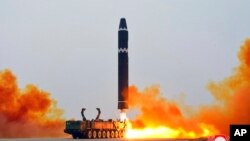North Korea has confirmed that the intercontinental ballistic missile it fired Saturday was the Hwasong-15, which it said was part of a “surprise” exercise to test its war readiness with a “mobile and mighty counterattack.”
According to a Sunday morning report by the state-run Korean Central News Agency, a mock “emergency firepower combat standby order” was issued at dawn Saturday. Guided by North Korea’s Missile General Bureau, the “high angle” ICBM launch was conducted at Pyongyang International Airport by afternoon, it said.
Authorities in South Korea had said the long-range missile was detected leaving North Korea’s Sunan area near the capital, Pyongyang, around 5:20 p.m. local time.
KCNA also posted similar launch specifications as reported by Japan and South Korea, reporting the Hwasong-15 traveled at a top altitude of 5,768.5 kilometers for nearly 67 minutes, covering a distance of 989 kilometers before reaching its target in the “open waters of the East Sea of Korea” to receive an “excellent mark.”
The ICBM had the capacity to reach the continental United States given a normalized range of 14,000 kilometers, Japan said.
North Korean state media credited a subunit, the First Red Flag Hero Company, for the feat, adding it is responsible for past ICBM successes as well, including the test launch of the Hwasong-17 on Nov. 18.
In a separate KCNA statement, Kim Yo Jong, the sister of North Korean leader Kim Jong Un, reiterated Pyongyang’s earlier accusation that the United States was using the United Nations Security Council as a “heinous anti-DPRK hostile policy implementation body.”
DPRK is the acronym for North Korea’s official name, the Democratic People’s Republic of Korea.
In the statement posted Sunday, Kim said Washington should “kick away nonsense” that it was open to dialogue, abandon its “foolish ploys to buy time” at the dialogue table, cease all actions that endanger North Korea’s security, and “think twice” for the sake of its own security.
North Korea’s Foreign Ministry on Friday issued a statement, blasting the U.S. for “coercively convoking” a United Nations Security Council meeting “to take issue with the DPRK’s right to self-defense,” even as it warned “unprecedentedly persistent and strong counteraction” to U.S. and South Korea joint military drills.
The United Nations Security Council had convened a closed-door meeting in New York on Thursday afternoon to discuss North Korea and nonproliferation, according to its website.
U.S. Ambassador to the U.N. Linda Thomas-Greenfield said a “candid discussion” was had on North Korea’s “unlawful WMD [weapons of mass destruction] and ballistic missile advancements,” in a tweet. It included meetings with the International Atomic Energy Agency and the U.N. Department of Political and Peacebuilding Affairs.
North Korea’s ballistic missile and nuclear weapons programs are banned under multiple U.N. Security Council resolutions.
Some analysts in Seoul anticipate additional provocative testing, including those related to achieving solid-fuel missile capabilities, as part of North Korea’s plans to upgrade its weapons capabilities by 2026.









